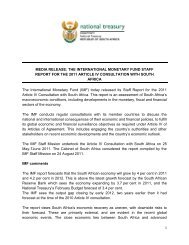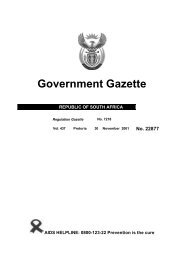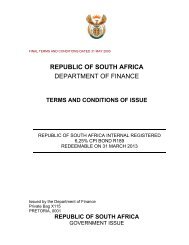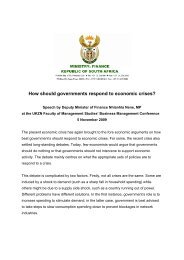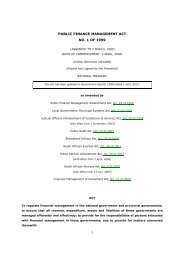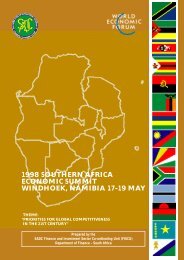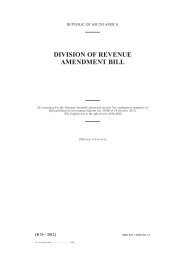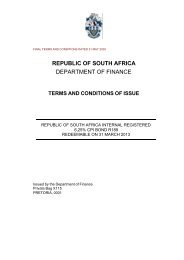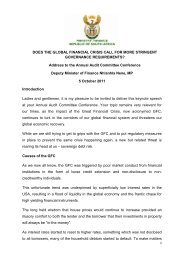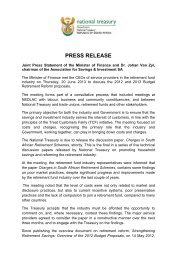1996 - National Treasury
1996 - National Treasury
1996 - National Treasury
You also want an ePaper? Increase the reach of your titles
YUMPU automatically turns print PDFs into web optimized ePapers that Google loves.
2-10<br />
these functions, the share of remuneration of employees in<br />
total expenditure typically exceeds 70 per cent.<br />
Other factors also contributed to the growth of remuneration<br />
of employees. These include marked increases in<br />
employment and average remuneration in several subnational<br />
authorities (including former own affairs<br />
administrations, TBVC states and self-governing territories),<br />
the phasing-out of racially discriminatory pay practices and<br />
improvements to the relative wage levels of lower paid<br />
workers.<br />
Interest payments have also grown relative to GDP during<br />
the period under review, partly as a result of higher interest<br />
rates. In addition, slower revenue growth than expenditure<br />
increases during the 1989 to 1993 recession impacted on<br />
the annual public sector borrowing requirement, leading to<br />
an escalation of the public debt and associated increased<br />
interest costs.<br />
The trend in the GDP share of subsidies reflects spending<br />
on export promotion, commuter transport and regional<br />
industrial development, while drought relief payments<br />
dominate the 1992/93 figure. Elimination of racial disparities<br />
in the levels of old age pensions and other social grants<br />
increased relative spending on current transfers to households.<br />
2.4 EXPENDITURE PLANNING<br />
2.4.1 The budgetary process<br />
The reform of the budgetary process introduced by the<br />
Department of State Expenditure and given effect during the<br />
preparation of the 1995/96 Budget has contributed to more<br />
effective fiscal planning and overall expenditure management.<br />
The planning process, which begins about eighteen<br />
months before the presentation of the budget to Parliament,<br />
comprises the following:<br />
• the identification of all activities rendered by a<br />
spending agency;<br />
• compilation of budgets from zero while at the same<br />
time reassessing the efficiency, effectiveness and<br />
economy of all activities to ensure that costs are<br />
limited to the minimum;<br />
defining the goals of the government in so far as<br />
these pertain to the spending agency or the function<br />
for which a spending agency is responsible;<br />
• defining and examining the rationale for each<br />
activity;<br />
• discarding inherited activities that do not promote<br />
agreed goals and establishing new activities which<br />
do reflect these goals;<br />
• prioritising all activities of spending agencies against<br />
an agreed set of criteria;<br />
• evaluation of the planning and reprioritisation<br />
exercises of the spending agencies by the Department<br />
of State Expenditure and task teams under its<br />
auspices;<br />
• formulation of a multi-year fiscal plan in which<br />
allocations will be made to functions based on their<br />
relative needs and priorities; and<br />
• determination of an expenditure level per year within<br />
the framework of a multi-year fiscal plan.<br />
Participation of relevant role-players takes place throughout<br />
the process and Cabinet, in the final instance, evaluates and<br />
approves spending allocations prior to submission of<br />
expenditure estimates to Parliament.<br />
As part of an ongoing review of the budgetary process and<br />
to contribute to the drafting of a White Paper on Budget<br />
Reform, the Department of State Expenditure will be convening<br />
a conference on expenditure budget reform in early<br />
April <strong>1996</strong>, involving several international authorities together<br />
with local experts and stakeholders.<br />
2.4.2 A medium-term expenditure framework<br />
As indicated in the 1995 Budget Review, the Government<br />
recognises the importance of a longer-term fiscal planning<br />
framework alongside the annual budgetary process. A multiyear<br />
fiscal framework is envisaged which will be updated on<br />
an annual basis to provide all role-players with greater clarity<br />
regarding public expenditure trends and priorities within a<br />
macroeconomic context. Presenting budgets in the context<br />
of a long-term expenditure framework will focus attention on<br />
what programmes deliver and the overall balance between<br />
expenditure allocations and will facilitate the selection of<br />
cost-effective and growth oriented combinations of policies.<br />
It is envisaged that a draft medium-term expenditure model<br />
will be available to assist in the preparation of the 1997/98<br />
Budget. The framework for this exercise has been designed<br />
with a view to facilitating the alignment of departmental<br />
programmes and budgets within the overall fiscal constraint<br />
and the testing of policy options.<br />
The Unit for Fiscal Analysis in the Department of Finance,<br />
the Department of State Expenditure and the Central<br />
Statistical Service have been collaborating on the initiative,<br />
which has also involved extensive consultation with departments,<br />
function committees and other analysts. The<br />
medium-term framework will provide a basis for quantifying<br />
and programming the fiscal requirements of the envisaged<br />
Growth and Development Strategy. The Departments of



